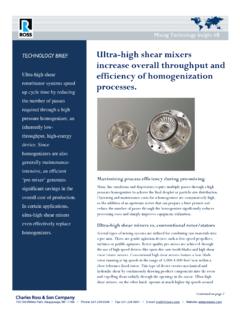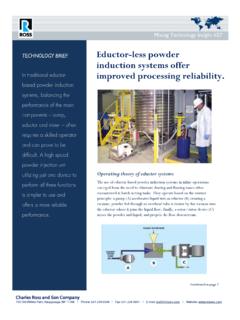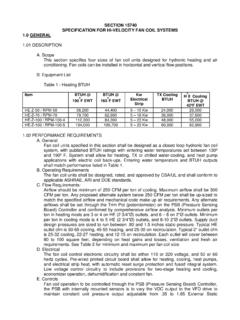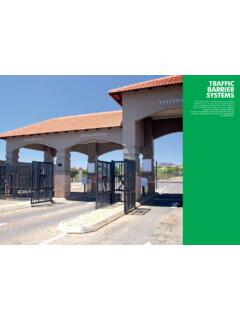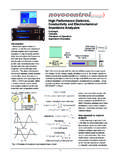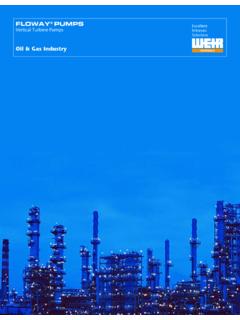Transcription of All about High Speed Dispersers - High Shear Mixers
1 All about high Speed Dispersers A White Paper Prepared By Charles Ross & Son Company Ross White Paper: Solutions to Batch Mixing Issues Page 2 of 11 All about high Speed Dispersers Abstract The classic high Speed Disperser is a common mixing tool used throughout the process industries. This white paper discusses different designs, features, custom configurations and sample applications to serve as a helpful guide in equipment selection. Introduction The high Speed Disperser, also previously called high Speed Dissolver, is a standard workhorse used in the manufacture of chemicals, plastics, coatings, inks, paints, adhesives, composites and many other products. An economical and relatively simple piece of mixing equipment, its primary purpose is to incorporate powders into liquid and break down particle agglomerates to produce a fine dispersion.
2 Running at tip speeds up to around 5,000 ft/min, the open disc blade of the high Speed Disperser creates vigorous turbulent flow within a low viscosity batch. It also generates a characteristic vortex into which dry ingredients can be added for quick wet-out. The disperser blade may be located on- or off-center depending on the depth of the vortex (an off-center blade produces a smaller vortex and reduces air entrapment). As the batch thickens or increases in volume, blade Speed is adjusted to maintain the vortex and rate of material turnover. A few other basic guidelines are typically followed in the sizing and operation of the high Speed Disperser, including: Normal operating viscosity range: water-like to around 50,000 centipoise (cP) Motor specification: 1HP for every 10 gallons of product Disperser blade diameter: approximately 1/3 of vessel diameter Disperser blade location: blade diameter off the vessel bottom blade diameter below the batch surfaces.
3 Full holding capacity of mix vessel: about 130% of batch size to provide sufficient freeboard above the product level. Typical blade designs: Saw-tooth design. Most popular blade; balances high Shear dispersion with pumping action. high vane design. high pumping capacity and minimal Shear ; ideal for let-down requirements and heat-sensitive products. Cutter design. Provides good batch movement and high Shear mixing; excels in high viscosity and high solids batches. Polypeller. Made from Ultra- high Molecular Weight Polyethylene for superior wear-resistance to abrasive applications. Ross White Paper: Solutions to Batch Mixing Issues Page 3 of 11 Laboratory high Speed Dispersers Most lab-scale high Speed Dispersers today, used for batches ranging from 1 to 15 liters, are conveniently equipped with an electronic lift for raising and lowering the blade.
4 Heavier duty bench-top Mixers feature an air/oil hydraulic lift, a set-up that resembles that of production-size floor-mounted models. To accommodate variations in the batch size, different diameter disperser blades are supplied. The mixer base also allows users to utilize any number of commercially available glass beakers, metal cans or plastic buckets to serve as mix vessels. Vacuum-rated units, on the other hand, consist of a mixer cover that matches to a dedicated vessel. Sight/charge ports are installed on the cover for easy ingredient additions and for viewing the batch during the mixing cycle. In an R&D setting, multi-purpose Mixers designed for use with interchangeable agitators are very essential tools. Each agitator that easily swaps with another extends the spectrum of tests that a single machine can accomplish.
5 Mixer versatility and utility are thus increased without taking up additional space. For this reason, Ross laboratory Mixers are offered with different size disperser blades, propeller blades and rotor/stator assembly with different style stator heads. While high Speed Dispersers are generally used for straightforward solid-liquid mixing requirements, rotor/stator Mixers are utilized for emulsification, particle size reduction and homogenization purposes. Conventional rotor/stators, also called high Shear Mixers , consist of a four-blade rotor running at tip speeds in the range of 3,000-4,000 ft/min within a close tolerance fixed stator. This type of device imparts intense mechanical and hydraulic Shear by continuously drawing product components into the rotor and expelling them radially through openings in the stator. Laboratory high Speed Disperser with electronic push-button lift, shown here with a built-in thermoprobe.
6 Bench-top high Speed Disperser with air/oil hydraulic lift. Vacuum-rated high Speed Disperser with custom vessels which clamp to the mixer cover for a vacuum-tight seal. Ross White Paper: Solutions to Batch Mixing Issues Page 4 of 11 Pilot- and Production-Scale high Speed Dispersers Dispersers equipped with a 5HP motor or larger are considered pilot- and production-scale Mixers . The standard design is a floor-mounted unit with an air/oil hydraulic lift which allows the use of interchangeable vessels and the handling of low liquid volumes during the initial stages of mixing. Having the ability to raise and lower the disperser blade is also beneficial in terms of eliminating any stratification or possible layering within the batch.
7 Vacuum-capable high Speed Dispersers may include a hydraulic lift but blade position cannot be adjusted during mixing. Instead, a secondary blade can be used to ensure proper batch turnover. Safety limit switches prevent operation of the mixer while in the raised position or without a mix vessel in place. Tank-mounted Dispersers are used in applications wherein the batch size does not vary or at least not severely. At all stages of the mix cycle, product level must always be sufficiently above the disperser blade s fixed location. The mixer is installed on the vessel cover or an agitator bridge. In a Ross laboratory mixer, the batch rotor/stator is designed to be easily swapped with a disperser assembly (and vice versa) without having to adjust or disassemble the pulleys, bearing housing, or shaft. Standard floor-mounted model Tank-mounted disperser Vacuum-rated dual-blade disperser Ross White Paper: Solutions to Batch Mixing Issues Page 5 of 11 APPLICATION SNAPSHOT In a fiberglass pultrusion process, raw fibers are pulled and guided through a resin bath or resin impregnation system.
8 The wetted fibers are then formed into the correct shape and excess resin is squeezed out before they are fed into a heated steel die to cure the resin. The finished product is a Fiber Reinforced Polymer (FRP) composite. At one such manufacturing facility, a Ross 10-HP high Speed Disperser supplied with eight (8) custom-made 50-gallon vessels is being used in batching the thermosetting resin. Pot life is limited so only small batches are made. Fillers, catalysts, pigments and other additives are charged through the loading hopper with safety grating and dispersed into polyester resin. As one batch is underway, the next vessel is being filled with the proper amount of liquid resin. An air-operated diaphragm pump is mounted and plumbed to the bottom of each mix can for fast transfer of the finished mixture to the pultrusion line.
9 Ross high Speed Disperser with Custom 50-gallon Tanks Ross White Paper: Solutions to Batch Mixing Issues Page 6 of 11 As batch volumes become larger, maintaining the recommended design parameters become more challenging. Because blade diameter is essentially determined by the vessel size, very large high Speed Dispersers eventually require horsepowers that are impractical. Some attempt to solve this problem by installing a smaller diameter blade that runs at higher shaft speeds to maintain the desired ~5000 ft/min dispersion tip Speed . However, this has the danger of approaching critical Speed and increases the risk of premature equipment failure. A safer option is to utilize supplemental agitation, such as a slow Speed propeller or an anchor agitator, to help feed product to the disperser blade, improve bulk flow within the vessel, and eliminate dead zones.
10 In cases where a multi-agitator set-up is not convenient, one possible solution is to work within a reasonable batch size and focus on ways to accelerate throughput. For instance, a high Speed Disperser equipped with a swivel system is capable of very fast changeovers. Typical tank-mounted Dispersers cannot start the next batch until all contents of the previous run are emptied and fresh raw materials are charged to the same vessel. The mixing vessel is obviously operated and cleaned from a fixed location due to its large size. Thus any mixer that can be raised hydraulically out of one vessel, rotated and lowered into another vessel allows for a more nimble and cost-efficient production. Very large high Speed Dispersers (75 to 500 HP) are typically built for mounting on a mezzanine. The photos on the left show a custom 100HP Ross high Speed Disperser with Swivel-Lock Assembly.






